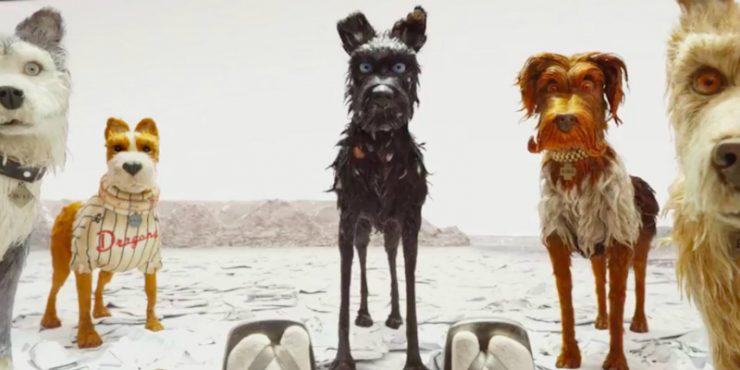Since his fourth feature, The Life Aquatic with Steve Zissou, filmmaker Wes Anderson has shown an affinity with traversing the world and force-feeding his sharp, deadpan view of humanity into these non-American settings. The films often take place in a fictional facsimile of a real foreign country, the use of English often being a funny sidenote, meant to humorously detail the vanities and insecurities of his main characters. You see, nearly all of Wes Anderson’s movies are, in some way, about whiteness and half of them are about how whiteness plays (or simply doesn’t play) in parts of the world where whiteness is not the majority. This is true too of Isle of Dogs, his latest movie and his second animated feature. The film takes place in a near-future Japan that is caught in a maelstrom of political turmoil over the fate of its dogs. Isle of Dogs focuses mainly on the dogs themselves, a ragtag group of neurotic, English-speaking canines uneasy about their situation.
Our main group includes Chief (Bryan Cranston), a worse-for-wear stray dog with a gruff personality and a tendency to bite. There’s also Rex (Edward Norton), a pedantic human-lover with a knack for putting everything to a democratic vote. There’s King (Bob Balaban), a former dog treat commercial star, and Boss (Bill Murray), a former sports mascot, and Duke (Jeff Goldblum), who loves gossip. All five live on Trash Island, the site of all of Japan’s dogs after Mayor Kobayashi (Kunichi Nomura) signed an executive order expelling all dogs after an outbreak of Dog Flu. Chief, a born scavenger, accepts his role on Trash Island more readily than his companions, who are ready to give in to despair until they run into Atari (Koyu Rankin), a 12-year-old boy and ward to Mayor Kobayashi. Atari crash landed on Trash Island using a makeshift aircraft. His goal? To find his dog, Spots (Liev Schrieber), and bring him back home.
Overjoyed to run into a human companion again, the five dogs agree to help Atari in his search for Spots, despite the reticence from Chief. The team must fight against government-issued agents and robot dogs sent to the island to retrieve Atari, all while racing against time as the government pushes to pass legislation that will not only expel all dogs but euthanize them. Tracy (Greta Gerwig), an American exchange student going to a Japanese junior high school is a vocal member of Japan’s pro-dog legion. Chronicling Atari’s journey, she hopes to end Mayor Kobayashi’s reign of anti-dog sentiment and convince those brainwashed by the regime into action before the government destroys all dogs, as well as Atari.
Anderson’s other animated film, The Fantastic Mr. Fox, also involved charming animals animated to look like elaborate roadkill surrounded by humans with grotesque features threatening their lives. Stop-motion animation seems like the perfect place for Anderson to explore his craft. After all, his films are dioramic in nature. I like Isle of Dogs and I liked Mr. Fox as well, but both films feel like they’re too unrestrained in their visual restraint. Without the volatility of live action performance, Anderson’s stories become so compact and so precious. It’s unleaded Wes Anderson, which is probably a ball for all those who adore the aesthetic of his movies. As someone who does adore the aesthetic, I love it most when the performances fight against it. Watching his characters scratch and claw out of their highly-designed boxes is what makes them so beautiful to behold.
But Isle of Dogs works for what it wants to be. Its wink-wink affectations are funny and cute, and its emotional manipulations can cut you to the core. The animation, with its striking attention to detail, is crisp and wondrous to behold. With a score from Alexandre Desplat, the film’s soundtrack is lush and moving. Dogs and Mr. Fox manage to feel more like labors of love than his other films. There’s a childish enthusiasm behind them as opposed to the infantile petulance that resides within his live action characters. Whether the two movies work as films for children isn’t really for me decide (but since you’re asking: they don’t), but you get the sense that this is the kind of film that Anderson would have enjoyed when he was a child.
I feel like I can’t leave here without coming back to Anderson’s portrayals of whiteness and non-whiteness. Both Isle of Dogs and 2007’s The Darjeeling Limited have been maligned for Anderson’s cultural tourism. In both films, jokes are made about our English-speaking protagonists and their relation to the native languages where they reside. The dogs in Isle of Dogs stand in for whiteness and occasionally comment on Atari’s language as a burden. The cultural politics in this film and Darjeeling are messy and imperfect, open to criticism which they have received. Both movies do, however, show an almost overwhelming adoration for the cultures they showcase, and a marked disdain for the white characters who approach it with indifference. It’s not Wes Anderson’s job to show us what is and isn’t beautiful about non-American cultures, but I also don’t necessarily think he is treating that responsibility lightly. He is one of America’s most thoughtful, expressive filmmakers, and Isle of Dogs fits right in there with the rest of them.
Directed by Wes Anderson










